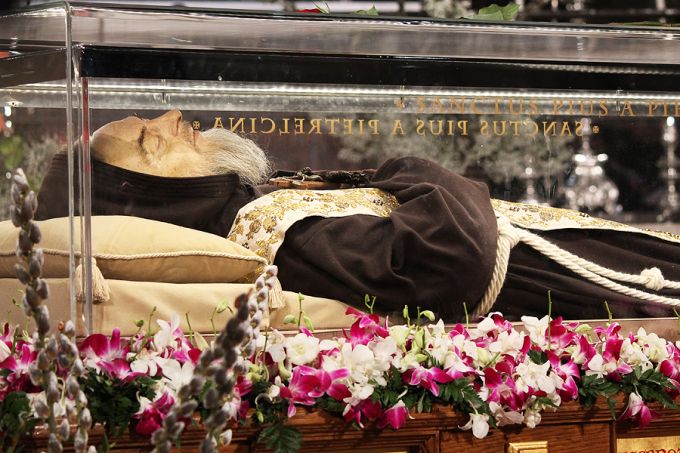Tuesday, May 8, 2018
PART TWO: Some Facts about St. Padre Pio
This is PART TWO in a series of amazing, uplifting, and encouraging facts about the life of the Franciscan stigmatist priest from Italy named Padre Pio. See Part One HERE. The details of his life are meant here to comfort those in particular who are in extreme pain, suffering, and illness, who can be edified by the life of this saint who perhaps suffered more than most saints in the history of the Catholic Church. Please share these posts with the sick by email, Facebook, etc. Thank you.
Padre Pio was in constant, unimaginable pain all his life, all over his body, but especially for the 50 years he miraculously bore all Five wounds that Our Blessed Lord bore during his Crucifixion.
Yet Padre Pio was constantly in a cheerful, playful, and comical mood, full of joy and hope in God.
At the same time, he was also often full of sorrow and tears how sin afflicted Our Lord in His Passion and Death, as re-represented on the daily altar at Mass. He was especially angered at irreverence, sacrilege, and disobedience of Church authority. But when a penitent was scrupulous or acting eccentric, he typically was gentle and light-hearted with them in giving his advise.
For a time in his life, he would miraculously cry so much in sorrow for the sins of mankind, while standing in choir with the other friars for prayers, that they would have to place towels around him on the ground to soak up all the tears.
His daily motto he often repeated to penitents and other visitors was: "Pray, Hope, and Don't worry."
He would typically preach very short sermons that were only 1-2 minutes long, but packed with spiritual wisdom and the teachings of Christ and His Church. Listen to this moving EXAMPLE.
Padre Pio, while seminary trained, was a very simple, thinking man, reflecting his simple, peasant background. He was not a theologian or philosopher, but loved to read the Bible, and to write simple, letters of spiritual direction, as a pastor and priest of souls, to his "spiritual children." Yet, Padre Pio had an excellent grasp of the core lessons of theology, the liturgy, and the pastoral duties of a priest.
He often gave off the miraculous scent of roses or perfumes. One day during Mass, the whole Church became full of the smell of roses, as witnessed by a packed church of visitors.
Cardinal Wojtyla of Poland, the future Pope John Paul II, visited Padre Pio, who confided to him, as he had rarely done to anyone, that he also bore a wound of Christ across his shoulder, which many people do not know Christ had suffered during His Passion.
Later, Cardinal Wojtyla wrote Padre Pio several times, to ask for prayers of healing for members of his diocese who were suffering from cancer or other life-threatening illnesses, and each time Padre Pio wrote back they would be healed, and then they were healed.
Padre Pio's body, as it lies inside a glass casket for pilgrims to see and venerate, is miraculously incorrupt, with no scientific explanation.
It seems that he is a unique saint in the Catholic history of saints, in that he was the only saint who was: a priest with the full stigmata, a victim soul, a mystic, exemplifying through his own daily passion (especially the mystical way he was united to Christ's suffering during each Mass) the fullness of the sacramental priesthood.
Some days he spent 15-19 hours in the confessional, and beginning in 1950, the confession lines were so long the Friars would create a wait list that often was ten days out.
Every day the Friars received letters to Padre Pio, so many that a team of priests and brothers were assigned to sit down, read them, and try and answer them on Padre Pio's behalf, while he would bless the letters and include a holy card.
Every day Padre Pio went outside to walk around with the pilgrims and talk to them, answering questions, giving short catechism lessons, and often handing out holy cards and holy medals he had blessed. People were constantly asking for his blessing.
Padre Pio could read people's souls. Often he would help the penitent remember unconfessed sins. But if the person was not truly contrite, but just going to confession for the amusement of hearing what he would say, he would know and angrily (justly so) order them out of the confessional, not because they disrespected him, but to admonish them for disrespecting the Sacrament of Confession.
One day after Mass a crowd filled the entrance to the sacristy. After taking off his vestments, he was not able to get past the crowd. As witnessed by priests who have given sworn testimony, Padre Pio levitated in the air, hovering above the height of the crowd, and walked over their heads to get past them.
Padre Pio was attacked by the devil on a nightly basis in his cell, leaving serious injury, that only the brothers who helped care for him knew about. These attacks persisted throughout his life. Sometimes the demon would physically hurl him across the room against the wall.
The hospital he founded next to the Friary still exists today, and is overseen by the Vatican.
All the miracles and wonders surrounding Padre Pio's life are a testament to the divine love God has for each one of us.
Short BIO HERE. St. Padre Pio, pray for us!
(Part Three coming soon!)
Posted by
Joseph Ostermeir


